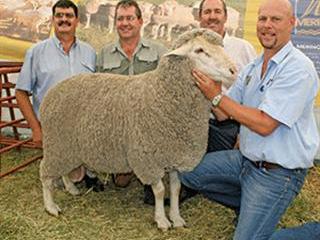This bird is Derry WateLeon Petze, the 1999 SCMDPR winner. It was bred in South Africa by JA Fernhout at Sniper Lofts.
Since the inception of the Sun City Million Dollar Pigeon Race (SCMDPR) pigeon fanciers all over the world have been inspired to even bigger dreams. N ever before has there been so much excitement about racing pigeons. All that hard cash and cars.
Professionals versus the amateurs
In the 12 years since its inception, the SCMDPR has paid out about million (R465 million) in combined prize money. Hobbyists have turned professional and registered their lofts as businesses. At least one of those business has been taken to court by the receiver of revenue. If you win at the top, rather declare your profits like a good, honest citizen. Hobbyists who haven’t claimed expenses in terms of building lofts, buying good stock and quality feed, should liaise with a financial adviser. For some fanciers in Europe, breeding pigeons is their primary source of income. Highly skilled, full-time administrators care for multimillion dollar lofts that house thousands of racing pigeons. Hans Eijerkamp and Zonen, from the Netherlands, own pigeon breeding stations in various parts of the world. The renowned Herbots brothers from Belgium breed, buy and sell pigeons everywhere. The Herbots family won 14th position at this year’s SCMDPR with their pigeon, Seeking the Sky. The royal lofts of the queen of England are based in Sandringham, in the UK. Birds from the loft are entered into the SCMDPR.
Personal reward
But winning at the SCMDPR is not always about the money. For some it’s the fulfilment of owning a world-class pigeon. Some want the winning handshake, while others just want to beat the opposition who to them are the ultimate enemy. Greed is a certain enemy. Stories abound of fanciers taking a second bond on their homes in order to afford the entry of a few birds at 000 (R7 661) an entry.
The challenge
To challenge a good score in the SCMDPR one must not only have good pigeons, but also the right ones for the race system and climatic conditions. There are 250 cash prize payouts on the main race, but before that event there are nearly a 100 other cash prizes and five motorcars awarded to winners of the prefinal flights. O ver the years the quality of the pigeons sent to the race is conservatively estimated to have increased by at least 25% a year. Fanciers are breeding better birds. As the race now enters its 13th term, it could be argued that it takes not a good pigeon to win, but a superior pigeon. From humble amateur to professional fancier, all need to realise that they are taking on the world. When examining the results sheets, it becomes clear that fanciers from some countries do better research. One country that stands out in this regard is Belgium. Their pigeons dominated in the prefinals. Over the past few years Germany has settled back from their overall dominion. The prestige of the Netherlands in 2nd position this year is also the fruit of years of dedication by Gerhard Koopman, a world-renowned champion. – Thomas Smit ([email protected] or call (011) 680 4778.) |fw
Birdy the role model
Birdy, entered by the German partnership Sudhoff and Van Beers is the 2008 ace-pigeon, the best pigeon to have ever flown in the history of the SCMDPR. It scored 10th in the 2008 SCMDPR final and was auctioned for R800 000 to Mark Kitchenbrand from Alberton in SA. Very few racing pigeons tolerate the strain and maintain condition to score at the top, week after week. In the past, a number of pigeons held out to score in the prefinals, but faded in the final. A few superstars appeared to have tried too hard in the prefinal and then shot up in the final.
But none like Birdy. It’s a pigeon that is the product of years of intensive breeding. The egg from which she hatched was laid in the loft of Willie Van Beers in Germany on 9 April 2007. Three birds bred from the same parents won 14 races within 14 weeks. Birdy’s sire and both grandparents on the sire’s side are world-champion class against 1 200 members – compared to most SA Clubs in Gauteng that struggle to hold 20 members. Birdy’s dam is a superior racer in the same top class. The race circumstances are tough, young-bird races – against mostly an east wind – and continuous racing for 14 weeks on distances up to 700km. Birdy was bred for such race conditions and the system during the SCMDPR. You would have to select from birds that could manage to get home in 8 hours 36 minutes without having a notable rest – it’s the guts factor and all-round supremacy.









